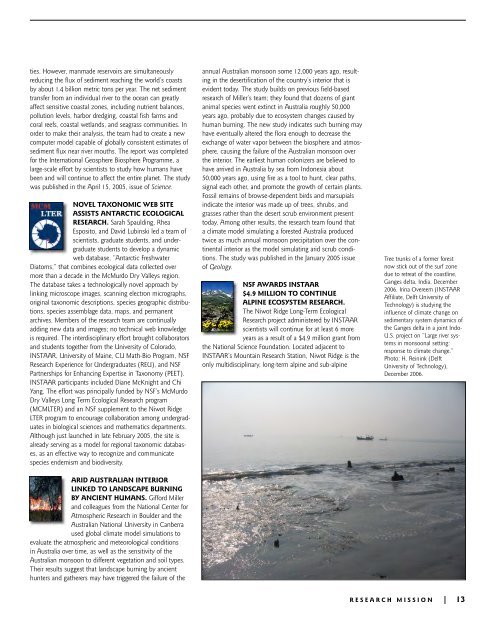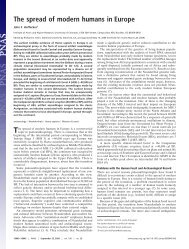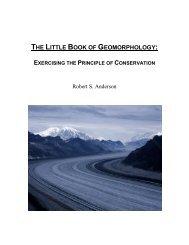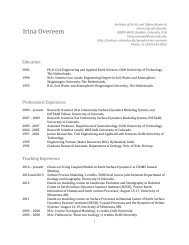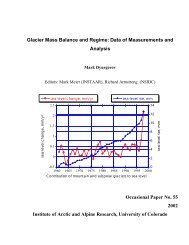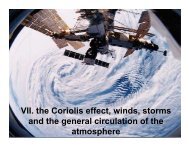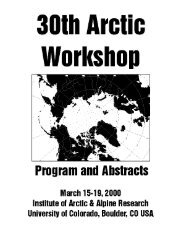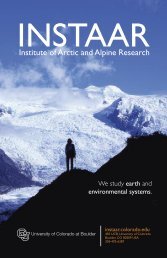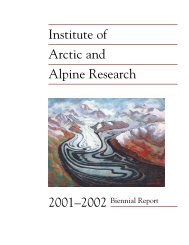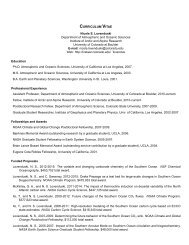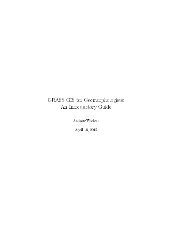Crossing mobile sand in search<strong>of</strong> eggshells, Talaki, southernMadagascar, April 2<strong>00</strong>6. Photo:Giff Miller (<strong>INSTAAR</strong>).mer rains. After 45,<strong>00</strong>0 years ago, the eggshell evidenceshowed emus successfully switched to a diet <strong>of</strong> mostlyshrubs and trees characteristic <strong>of</strong> drier conditions. ButGenyornis, which also preferred the nutritious grass prior to50,<strong>00</strong>0 years ago, failed to make the dietary switch andbecame extinct shortly after humans arrived. There were nosignificant swings in the continent’s climate during thatperiod, suggesting that humans indeed had a hand in theextinctions.The study was published in the July 8, 2<strong>00</strong>5, issue <strong>of</strong>Science. Image: enlargement <strong>of</strong> a painting <strong>of</strong> extinctGenyornis courtesy <strong>of</strong> Peter Trusler, from the book Wildlife<strong>of</strong> Gondwana by P. Vickers-Rich and T. Rich (Indiana<strong>University</strong> Press).NEW MARINE SUBSTRATESDATABASE FOR U.S. ATLANTICCONTINENTAL MARGIN. Chris Jenkinsand colleagues at the U.S. Geological Surveyreleased the first regional <strong>cover</strong>age <strong>of</strong> theusSEABED database, a large compilation <strong>of</strong>samples data on marine substrates for theU.S. Exclusive Economic Zone (2<strong>00</strong> nautical miles out fromthe coast), in this case for the Atlantic margin. The databaseis now widely used by agencies and others for mapping,understanding, and managing the <strong>of</strong>fshore region. Thecontinental shelf, in particular, serves a variety <strong>of</strong> purposes:recreation, benthic habitats conservation, fisheries, commerce,transportation, national defense operations, wastedisposal, and engineering activities. The usSEABED databaseis built using dbSEABED processing s<strong>of</strong>tware createdby Jenkins. It has companion databases built along similarlines: for Australia, auSEABED, and globally, goSEABED.The databases rely on preexisting data, both published andunpublished, which the s<strong>of</strong>tware has been able to integrateand quality filter. The usSEABED database, using thedbSEABED program, differs from other U.S. databases inthat it incorporates both numerical and linguistic data onsediment texture, biology, seafloor characteristics such ashardness or sediment ripples, acoustic properties, and geochemicaland geotechnical analyses. This broad-basedapproach increases the data density over the seabed, allowingfor more complete maps and information. Future regionalreleases will be for the Pacific, Gulf <strong>of</strong> Mexico, andAlaskan margins.NITROGEN FERTILIZATION OF SOILPUTS PLANT SPECIES AT RISK,ESPECIALLY THE RARE ONES.Katherine Suding (former <strong>INSTAAR</strong> postdoc;current assistant pr<strong>of</strong>essor, <strong>University</strong><strong>of</strong> California, Irvine) led a team from eightuniversities in compiling data from previousand ongoing nitrogen-loading experiments on the alpinetundra <strong>of</strong> Niwot Ridge and in eight other ecosystems acrossNorth America. They found that rare plant species are sixtimes more likely than abundant species to be lost due tonitrogen fertilization <strong>of</strong> soil. While nitrogen increases theproduction <strong>of</strong> most plants, an excess amount <strong>of</strong> it createscompetition among plants for space that tends to drive rareplants out <strong>of</strong> existence, causing a loss <strong>of</strong> biodiversity. Theteam determined that other plant traits may put abundantplant species at risk in some settings: short height (shortplants receive less sunlight in the midst <strong>of</strong> taller plants); theability to convert atmospheric nitrogen, via bacteria, into aform that plants can use (the cost <strong>of</strong> supporting the bacteriahurts the plants); and a short life span (longer-livingplants do not have to start the life cycle all over again). Theteam’s work on nearly a thousand plant species will helppredict how patterns <strong>of</strong> plant diversity will decline as Navailability continues to increase globally in terrestrialecosystems due to human activities. The project was initiatedthrough the Niwot Ridge Long-Term Ecological Research(LTER) site, administered by <strong>INSTAAR</strong>, including experimentsby Tim Seastedt and Bill Bowman (both <strong>INSTAAR</strong>).The paper was published in the March 22, 2<strong>00</strong>5, issue<strong>of</strong> Proceedings <strong>of</strong> the National Academy <strong>of</strong> Sciences <strong>of</strong> theUnited States <strong>of</strong> America.HUMANS HAVE DRASTIC EFFECTON SEDIMENT TRANSFER TOWORLD’S COASTS. James Syvitski,Albert Kettner, and colleagues from the<strong>University</strong> <strong>of</strong> New Hampshire analyzeddata from more than 4<strong>00</strong>0 rivers aroundthe world that indicate humans are havingpr<strong>of</strong>ound and conflicting effects on the amount <strong>of</strong> sedimentcarried by rivers to coastal areas, with consequences formarine life and pollution control. The report found thathumans are stirring up much more sediment than expected,about 2.3 billion metric tons annually, through regionallydiverse patterns <strong>of</strong> agriculture and other soil erosion activi-12 | RESEARCH MISSION
ties. However, manmade reservoirs are simultaneouslyreducing the flux <strong>of</strong> sediment reaching the world’s coastsby about 1.4 billion metric tons per year. The net sedimenttransfer from an individual river to the ocean can greatlyaffect sensitive coastal zones, including nutrient balances,pollution levels, harbor dredging, coastal fish farms andcoral reefs, coastal wetlands, and seagrass communities. Inorder to make their analysis, the team had to create a newcomputer model capable <strong>of</strong> globally consistent estimates <strong>of</strong>sediment flux near river mouths. The report was completedfor the International Geosphere Biosphere Programme, alarge-scale effort by scientists to study how humans havebeen and will continue to affect the entire planet. The studywas published in the April 15, 2<strong>00</strong>5, issue <strong>of</strong> Science.NOVEL TAXONOMIC WEB SITEASSISTS ANTARCTIC ECOLOGICALRESEARCH. Sarah Spaulding, RheaEsposito, and David Lubinski led a team <strong>of</strong>scientists, graduate students, and undergraduatestudents to develop a dynamicweb database, “Antarctic FreshwaterDiatoms,” that combines ecological data collected overmore than a decade in the McMurdo Dry Valleys region.The database takes a technologically novel approach bylinking microscope images, scanning electron micrographs,original taxonomic descriptions, species geographic distributions,species assemblage data, maps, and permanentarchives. Members <strong>of</strong> the research team are continuallyadding new data and images; no technical web knowledgeis required. The interdisciplinary effort brought collaboratorsand students together from the <strong>University</strong> <strong>of</strong> Colorado,<strong>INSTAAR</strong>, <strong>University</strong> <strong>of</strong> Maine, CU Math-Bio Program, NSFResearch Experience for Undergraduates (REU), and NSFPartnerships for Enhancing Expertise in Taxonomy (PEET).<strong>INSTAAR</strong> participants included Diane McKnight and ChiYang. The effort was principally funded by NSF’s McMurdoDry Valleys Long Term Ecological Research program(MCMLTER) and an NSF supplement to the Niwot RidgeLTER program to encourage collaboration among undergraduatesin biological sciences and mathematics departments.Although just launched in late February 2<strong>00</strong>5, the site isalready serving as a model for regional taxonomic databases,as an effective way to recognize and communicatespecies endemism and biodiversity.ARID AUSTRALIAN INTERIORLINKED TO LANDSCAPE BURNINGBY ANCIENT HUMANS. Gifford Millerand colleagues from the National Center forAtmospheric Research in Boulder and theAustralian National <strong>University</strong> in Canberraused global climate model simulations toevaluate the atmospheric and meteorological conditionsin Australia over time, as well as the sensitivity <strong>of</strong> theAustralian monsoon to different vegetation and soil types.Their results suggest that landscape burning by ancienthunters and gatherers may have triggered the failure <strong>of</strong> theannual Australian monsoon some 12,<strong>00</strong>0 years ago, resultingin the desertification <strong>of</strong> the country’s interior that isevident today. The study builds on previous field-basedresearch <strong>of</strong> Miller’s team; they found that dozens <strong>of</strong> giantanimal species went extinct in Australia roughly 50,<strong>00</strong>0years ago, probably due to ecosystem changes caused byhuman burning. The new study indicates such burning mayhave eventually altered the flora enough to decrease theexchange <strong>of</strong> water vapor between the biosphere and atmosphere,causing the failure <strong>of</strong> the Australian monsoon overthe interior. The earliest human colonizers are believed tohave arrived in Australia by sea from Indonesia about50,<strong>00</strong>0 years ago, using fire as a tool to hunt, clear paths,signal each other, and promote the growth <strong>of</strong> certain plants.Fossil remains <strong>of</strong> browse-dependent birds and marsupialsindicate the interior was made up <strong>of</strong> trees, shrubs, andgrasses rather than the desert scrub environment presenttoday. Among other results, the research team found thata climate model simulating a forested Australia producedtwice as much annual monsoon precipitation over the continentalinterior as the model simulating arid scrub conditions.The study was published in the January 2<strong>00</strong>5 issue<strong>of</strong> Geology.NSF AWARDS <strong>INSTAAR</strong>$4.9 MILLION TO CONTINUEALPINE ECOSYSTEM RESEARCH.The Niwot Ridge Long-Term EcologicalResearch project administered by <strong>INSTAAR</strong>scientists will continue for at least 6 moreyears as a result <strong>of</strong> a $4.9 million grant fromthe National Science Foundation. Located adjacent to<strong>INSTAAR</strong>’s Mountain Research Station, Niwot Ridge is theonly multidisciplinary, long-term alpine and sub-alpineTree trunks <strong>of</strong> a former forestnow stick out <strong>of</strong> the surf zonedue to retreat <strong>of</strong> the coastline,Ganges delta, India, December2<strong>00</strong>6. Irina Overeem (<strong>INSTAAR</strong>Affiliate, Delft <strong>University</strong> <strong>of</strong>Technology) is studying theinfluence <strong>of</strong> climate change onsedimentary system dynamics <strong>of</strong>the Ganges delta in a joint Indo-U.S. project on “Large river systemsin monsoonal setting:response to climate change.”Photo: H. Reinink (Delft<strong>University</strong> <strong>of</strong> Technology),December 2<strong>00</strong>6.RESEARCH MISSION | 13
- Page 1 and 2: INSTAARInstitute of Arctic and Alpi
- Page 3 and 4: BiennialReport2005-2006Institute of
- Page 5 and 6: INSTAAR: An Earth andEnvironmental
- Page 7 and 8: CU-Denver campus where she helped t
- Page 9 and 10: Where in the world is INSTAAR? Acti
- Page 11 and 12: The instrument was deployed on NOAA
- Page 13: altered by humans over the past 200
- Page 17 and 18: Arctic WorkshopThe annual Arctic Wo
- Page 19 and 20: Wendy Roth (INSTAAR) explains the p
- Page 21 and 22: camera equipment. These laboratorie
- Page 23 and 24: Research Grants: Fiscal Years2004-2
- Page 25 and 26: Ogilvie, Astrid: NSF. HSD: Human an
- Page 27 and 28: Theses Completed2005Breiter, Nehale
- Page 29 and 30: Gifford MillerGEOL 1060, Global Cha
- Page 31 and 32: Lana Cohen, MS, Atmospheric and Oce
- Page 33 and 34: Trevor Popp, PhD, Geological Scienc
- Page 35 and 36: Societal Outreach andInformal Educa
- Page 37 and 38: A group of students from Southern H
- Page 39 and 40: Outreach SpotlightsUNDERGRADUATE ME
- Page 41 and 42: Spotlights: Honors, Awards,and Reco
- Page 43 and 44: TIM SEASTEDT WINS THE 2005PACESETTE
- Page 45 and 46: Structure of hierarchically organiz
- Page 47 and 48: William F. ManleyFellow of INSTAAR.
- Page 49 and 50: Alan R. TownsendFellow and Associat
- Page 51 and 52: GeophysicsEdmund AndrewsChief River
- Page 53 and 54: INSTAAR Visiting Scientists,2005-20
- Page 55 and 56: Chris JarosSupervisor: Diane McKnig
- Page 57 and 58: INSTAAR Noon SeminarsSpring 2005Tad
- Page 59 and 60: Graduate Student TalksSpring 2005Ry
- Page 61 and 62: Journal and BooksArctic, Antarctic,
- Page 63 and 64: Publications2005Adams, P. N., Storl
- Page 65 and 66:
“El Nino suppresses Antarctic war
- Page 67 and 68:
European settlement of Lake Eyre, S
- Page 69 and 70:
tion of Baffin Island, Arctic Canad
- Page 71 and 72:
and soil quality for sustainable gr
- Page 73 and 74:
Andrews, J. T., Eberl, D. D., and K
- Page 75 and 76:
Cleveland C. C., Reed S. C., and To
- Page 77 and 78:
and Pierre Y. Julien. Journal of Hy
- Page 79 and 80:
Tributaries to the ColoradoRiver th
- Page 81 and 82:
Rocchi, S., LeMasurier, W. E., and


